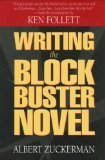Kick it up a Notch: Top Tips on Writing a Page-Turning Novel
We all want to write an engaging, page-turning story. But that’s harder said than done, as is proven by the number of times I leave a movie complaining that it was one long bull crap moment. There are tips and tricks to successfully writing a can’t-put-it-down book. Eileen Goudge is here today to share some of them with us…

Courtesy: Sam Beckwith at CC
If you’ve watched the hit TV show “24”, you know that every day in the life of hero Jack Bauer is a really, really bad day. When he’s not hunting terrorists he’s saving a major city from total annihilation. Is any of it remotely believable? Hell no. But we watch anyway. Why? Because the action moves at such a rapid clip, we don’t pause to reflect on the gaping plot holes until the credits are rolling. (Seriously, a middle-aged guy singlehandedly taking out a dozen armed terrorists?)
It’s the same reason authors like Stephen King have legions of fans. King is a master of plot and pacing. He knows that to create a novel that’s addictive you have to “kick it up a notch,” in the words of chef Emeril Lagasse. King’s current bestseller, Mr. Mercedes, had me at page one. It was off and running when I still had one foot on the ground climbing into the passenger seat. (It contains some Jack Bauer-like heroics, is all I can say without being a spoiler.) Is it the kind of stuff that would ever happen in real life? Doubtful. But who cares? We get enough real life in our own lives, and it’s usually pretty tame compared to a day in the life of Jack Bauer. Whether it’s a novel or filmed entertainment, fantasy or reality-based, we all want the same thing when reading a book: to be swept away.
So how do you accomplish this when you’re writing a novel? How do you take a low-octane plot and kick it up at notch?
Don’t be afraid to be over the top. Your plot doesn’t have to be in the realm of the probable, just believable enough to keep readers from rolling their eyes in disbelief. The only rule is that it has to make sense in the context of the story so it doesn’t seem out of character.
When I first started out as a writer I made it a practice to keep up with what was selling by reading at least one book by each of the authors whose titles frequently appeared on the New York Times bestseller list. If you want to understand the perennial popularity of a Danielle Steel, check out Palomino. The heroine is not only dumped by her cheating husband, an anchor on the local news channel, she then has the torment of watching him and his now-pregnant girlfriend/co-anchor on TV every day. And that’s just the first chapter. Before she’s paralyzed in an accident.
You may roll your eyes at this plot line, but in the hands of a skilled writer like Steel, it’ll have you turning the pages too fast to think, “Please. Like this would ever happen!”


In my first novel, Garden of Lies, which was a New York Times bestseller, my doctor heroine is faced with an unwanted pregnancy as a first-year intern. She agrees to end the pregnancy only if her doctor boyfriend will perform the abortion. She wants him to know it’s a big deal, not the minor procedure he seems to think it is. In ending a life they’re both scarred for life. And that’s just one of the subplots. The main plot is the classic tale of babies switched at birth with a twist: It’s the mother of one of the babies who consciously makes the switch.
Create high stakes. It’s one thing to have the protagonist lose his job or have the bank foreclose on his house. We read about this sort of thing every day in the news, so it doesn’t seem out of the ordinary; we feel for the person crying on TV because they lost their house and wish him or her well. With fiction, we want the exact opposite: more pain and suffering. If the protagonist is thrown into hot water, we want that water to be scalding.
Take The Firm, for instance—the novel that launched the mega-bestselling John Grisham’s career. The protagonist, Mitch, not only suspects there’s something fishy going on at the law firm that’s just hired him, but he notices the mortality rate among junior partners is unusually high. Soon he’s on the hit list and being chased, not only by the crooks, but by the mob and FBI. Who cares if that’d likely never happen in real life and you wouldn’t survive to tell the tale if it did? It makes for a compulsively readable novel and was made into a film that was a box-office hit.
Make us care before you toss your hero into hot water. There’s a reason you don’t see a dead body in the opening pages of my newest title, Bones and Roses (Book One of my Cypress Bay mystery series). I wanted readers to first get to know my amateur sleuth Tish—a recovering alcoholic who lost her mom at a young age—so when the corpse does turn up, they’d understand and appreciate the impact it has on her.


In opening scenes, suspense should come from the protagonist himself (or protagonists if it’s a multiple-viewpoint novel). Readers will want to know more about this character, so they’ll keep turning the pages to find out what happens next. If the author fails to create reader sympathy for the protagonist before he or she is put in a tight spot or a tight spot becomes even tighter, the reader won’t care whether or not he or she finds a way out.
Take The Shining, by Stephen King. King foreshadows the horrors to come in an opening scene in which down-on-his-luck protagonist Jack Torrance is interviewing for the job of caretaker of the Overlook Hotel. You care what happens to Jack and his wife and son, and you suspect it’s not going to turn out all hunky-dory when he gets the job.
In short, if you haven’t developed reader sympathy for your protagonist, the sledgehammer blow on which the plot hinges won’t have as much impact.
Keep up the pace. Remember when you were a kid and your big brother would twist your arm behind your back until you cried “uncle”? There’s no crying uncle in a taut, fast-paced novel. As you build toward the climax, it needs to be fast and furious with no letting up. In Michael Kortya’s masterful suspense novel, Those Who Wish Me Dead, a wilderness guide is leading a group of at-risk youths—among them, a kid who witnessed a murder and is being hunted by killers. Throw in a former U.S. marshal who has her own reasons for finding the kid, a forest ranger with a tortured past, the hero’s plucky wife back at the ranch, and a couple of really scary psychopaths, and you have a potent blend that’ll get the reader’s pulse pounding like a triple shot of espresso.
You write romance? Same rule applies as with horror and suspense novels: keep those pages turning with memorable characters and a compelling plot. Will Scarlett find happiness with Rhett? Will Bridget Jones get over herself and get with Mr. Darcy? These questions keep the plot bubbling and the protagonist stewing to perfect, delicious done-ness.


These are just a few of the basics. For more about how to write a page-turner, I recommend Writing the Blockbuster Novel, an excellent how-to written by my former literary agent and ex-husband, Albert Zuckerman. As someone who’s published a novel of his own and shaped countless others (including those of bestselling author Ken Follett), Al really knows his stuff.
 New York Times’ bestselling novelist Eileen Goudge wrote her first mystery, “Secret of the Mossy Cave,” at the age of eleven. She went on to pen the perennially popular GARDEN OF LIES—which was published in 22 languages around the world—and numerous other women’s fiction titles. BONES AND ROSES is the first book in her Cypress Bay Mysteries series. She lives in New York City with her husband, television film critic and entertainment reporter Sandy Kenyon. Online, you can find her at her website.
New York Times’ bestselling novelist Eileen Goudge wrote her first mystery, “Secret of the Mossy Cave,” at the age of eleven. She went on to pen the perennially popular GARDEN OF LIES—which was published in 22 languages around the world—and numerous other women’s fiction titles. BONES AND ROSES is the first book in her Cypress Bay Mysteries series. She lives in New York City with her husband, television film critic and entertainment reporter Sandy Kenyon. Online, you can find her at her website.
The post Kick it up a Notch: Top Tips on Writing a Page-Turning Novel appeared first on WRITERS HELPING WRITERS.
Writers Helping Writers
- Angela Ackerman's profile
- 1014 followers



